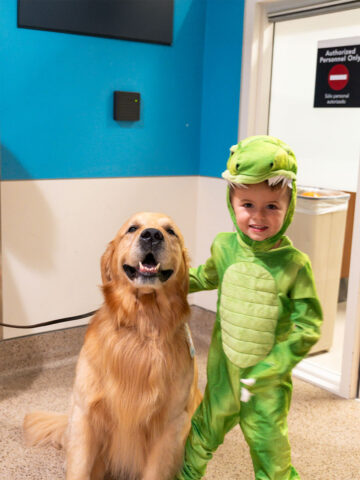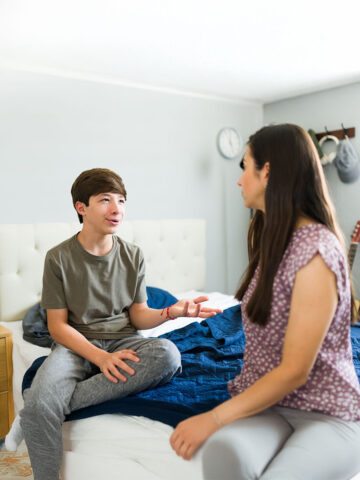By Dr. Sheila Modir, pediatric psychologist at CHOC
Parents/caregivers may often be reminding their child to “play nicely,” “remember to share,” or “be kind to your friend,” but from a developmental perspective, children tend to be more self-focused rather than focusing on others. This is a helpful skill for them as they are learning who they are, what they like and don’t like and how to get their needs met. But at the same time, children are hardwired for empathy and are curious and interested in helping others.
From a young age, kids may cry when they hear their friends cry or see them get hurt. Fortunately, providing children with the language and understanding of kindness is something that can be nurtured and taught! Teaching about kindness goes beyond a discussion or lecture, and is often done through examples and shared activities, like the ones listed below.
Strategies for teaching kids and teens to be kind
Model
Although this may sound redundant, modeling kindness is the best way to help a child understand kindness. When they see you be kind, they tend to follow suit! Kindness can be contagious and soon after they see you engage in an act of kindness, they may emulate. Things like holding the door open for someone, helping someone cross the street, saying please and thank you, and finally making sure our tone and how we sound when we speak to others is empathic, are all ways to demonstrate kindness to your child.
Practice loving kindness meditation
Even if your child is not old enough to sit for a longer meditation, there are ways to take parts of meditation and teach it to them. For example, the loving kindness meditation is the process of sending kind thoughts and well wishes to different people in our lives. You can have your child think of a person, group, or pet and send them kind thoughts like, “May Grandma be happy,” or “May Dad feel better,” or “May they be safe.”
Read books, books and more books
Books are a great way to talk about kindness as children tend to identify with the characters on the pages. Additionally, stories with powerful messages tend to stay with the child, especially since many children relish in reading the same book repeatedly.
For younger children, books like “ABCs of Kindness” (for ages one to four) or “Kindness Makes the World Go Round” (ages one to three) are places to start. For older children, books like “You, Me, and Empathy” (ages four to eight) provide more concrete scenarios that the main character experiences and allows for parents to open a discussion about compassion and kindness.
As you read, you can ask open-ended questions like, “How do you think he is feeling sitting by himself?” or “Wow, I see someone helping his friend out. What do you see on this page?”
Use emotion identification
Helping your child identify how they feel is a big step toward building empathy. When a toddler experiences frustration, you can help them name that feeling, such as “You are sad to see Chloe cry when she fell.” Naming the emotions helps reduce their ambiguity of them and allows the child to find ways to cope with them.
Another way is to put up a “feelings chart” in your home in a place where your child can easily access it, like on the fridge. Research has found that by the time an infant is 5 months old, they are able to differentiate their parent/caregiver’s facial expressions. Therefore, it is never too early to start introducing children to various emotional expressions! You can have the child guess what each feeling face is experiencing because as they recognize facial expressions expressing emotions, they can begin to recognize it in others and respond accordingly.

 Print this
Print this
Encourage kindness
Praising children when they engage in positive behaviors is important because it increases the likelihood of the behavior continuing. For nonverbal children, you can encourage them through interactions like clapping or high-fiving.
As children get older, providing them with labeled praises for positive behavior is important because then they know exactly what behavior they did and why you liked it so they can continue it.
For example, “Thank you so much for explaining that hard video game to your friend when he was confused. I saw how patient you were with him.”

Mental Health Education Program (MHEP) webinars
Resources for parents/caregivers:
- “ABCs of Kindness,” by Samantha Berger
- “We’re Better Together,” by Eileen Spinelli
- “Kindness Makes the World Go Round,” by Sesame Workshop
- “You, Me, and Empathy: Teaching children about empathy, feelings, kindness, compassion, tolerance, and recognizing bullying behaviors,” by Jayneen Sanders
- “Empathy for Kids: 30 Fun Activities to Foster Emotional Awareness, Compassion, and Kindness,” by Nicole Tolentino.
Get more expert health advice delivered to your inbox monthly by subscribing to the KidsHealth newsletter here.
Get mental health resources from CHOC pediatric experts
The mental health team at CHOC curated the following resources on mental health topics common to kids and teens, such as depression, anxiety, suicide prevention and more.





